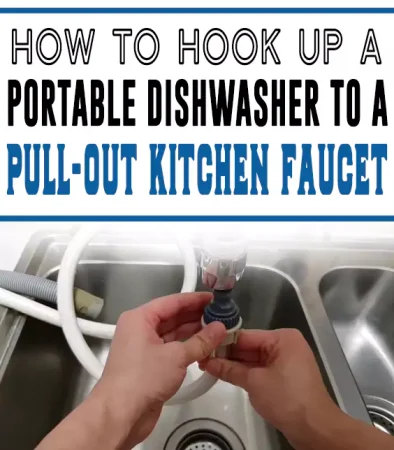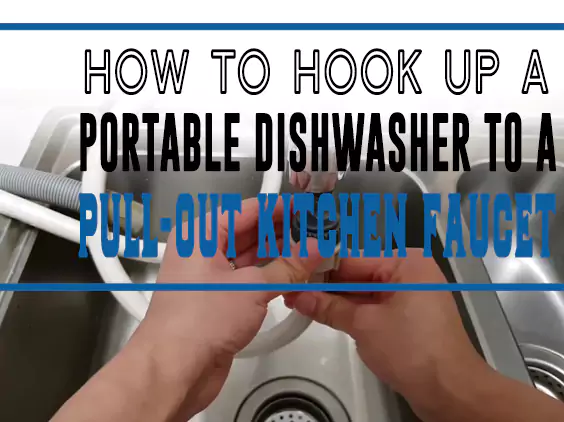To hook up a portable dishwasher to a pull-out kitchen faucet can get complicated especially when the faucet doesn’t fit the dishwasher hose.
You can bypass the challenge easily if you follow the right guide. Here’s how to do it properly.

Can You Use a Portable Dishwasher with a Pull-out Faucet?
A portable dishwasher can be connected with a pull-out faucet, but a faucet adapter is required for this.
A faucet adapter comes with the most portable dishwashers. But as I said earlier, not all faucet adapter fits with the faucet. In such a case, you must buy another adapter that is compatible with your faucet.
In rare cases, the need may arise for you to get a customized adapter. If your faucet is unique in size or shape and the standard adapter does not fit, you can replace it with a standard faucet.
Once you have gotten an adapter that fits your faucet, connecting it with the dishwasher won’t be difficult. But you must always test the water after you have hooked up the dishwasher to check for leaks.
Can you Hook a Portable Dishwasher to a Pull-out Faucet?
Yes, a portable dishwasher can be hooked up to a pull-out faucet. Just make sure to pick the correct type and size of hose fitting for your appliance.
How to Hook Up a Portable Dishwasher to a Pull-Out Faucet
The guide below highlights what you must do to have the right connection to keep your dishes clean while using your sink to drain used water.
Step 1: Unscrew the Sink Aerator
This step requires you to unscrew the aerator which has been hooked up with the kitchen sink spout. You can easily unscrew it with your bare hands. Hold the spout with one hand and use your stronger hand to unscrew it.
You can simply use your pair of pliers if using your bare hands seems difficult. Once the aerator has been unscrewed successfully, you must keep it separately in a place you can easily access it.
A good option is to keep it in any plastic container and put a tag on it to avoid confusion when you need it.
Once you complete this step, you can proceed with the installation of the faucet adapter.
Step 2: Install the Faucet Adapter
Every portable dishwasher comes with a special type of faucet adapter. Installing an extended adaptor to pull out the faucet gives you the option to use it with your dishwasher.
Always make sure the adapter fits with the faucet and if it doesn’t, purchase the appropriate adapter. Once you have the right adapter, simply screw it to the threaded part of the faucet spout.
Again, you can do this using your hands or you can use a screwdriver instead. The screwdriver helps you to tighten the adapter, it is important to confirm that both of the connections are tight enough to prevent leaks.
You should also switch on the water to confirm there are no leaks.
After you have confirmed this, switch off the faucet and proceed to the next step which requires you to place the dishwasher next to the sink.
Step 3: Place the Portable Dishwasher Close to the Sink
Now that the faucet adapter and aerator are in place, the next thing to do is to position the dishwasher beside the sink.
Since the dishwasher does not have too much pump power, it is important not to position it in a place far from the sink.
Now, you should connect the dishwasher hose with the adapter. There is a storage compartment below the sink, pull out the water hose from those compartments.
You will observe that the dishwasher hose has a collar, make sure you place the hose collar under the adapter and tighten it to prevent gaps and leaks.
Once you have done this successfully, it is time to test it.
Step 4. Run a Test
At this stage, you must run a general test on the work you have been doing. Switch on the faucet and check if any leaks are coming from the hose and connectors. If you found any leaks, just tighten the areas properly.
There may also be a need for you to make adjustments on the horse collar to stop any leaks coming from there also. This procedure is important because there is no other drain hose to where the dishwasher will drain to.
The water coming from the dishwasher will only drain through the hoses installed with the dishwasher.
You must also conduct a test to make sure that there is proper water flow and that the water which has been used is recycled back to the sink. Also, check the adapter to make sure no leaks are coming from all the connections.
After a successful test, you can now plug and run the dishwasher.
Alternative Ways to Dishwasher Hook up
There is an alternative for a dishwasher hook-up. Instead of connecting it with the faucet, you may hook up your dishwasher to the water line directly.
Though it may take a longer time, it will be worth your while if you intend to leave the dishwasher in that position for a longer period or if you still want to use your sink normally while your dishwasher is in use.
Before you begin this process of connecting your dishwasher directly to the waterline, you must first switch off the water running to the sink. Then, unscrew the pipe beneath the sink, the pipe is located between the valve and the faucet.
Make a tee installation after you unscrew the pipe, the tee installation allows an additional line connection. Once you have installed the tee, hook up your dishwasher by using a steel braided line.
The line will connect the water line to your dishwasher. Once it has been connected, make another connection between your dishwasher drain line and the garbage disposal.
This process is not difficult, because there is already a port on the garbage disposal specifically for the dishwasher drain line.
Now, you can switch on the water. Confirm that there are no leaks and prepare the dishwasher for use. Once this is done, the faucet will be free to be used because the dishwasher is already connected to the main lines.
An alternative way to hook up your portable dishwasher requires that you have a connection kit. You must also make sure your dishwasher is positioned near the sink so that the dishwasher can pump out water effectively.
You must remember that portable dishwashers are smaller in size compared to standard dishwashers, therefore, it does not have enough pump power to channel water from a long distance.
Summing It Up
Since the kitchen space is valuable, a portable dishwasher is always preferable to standard or traditional dishwashers, because buying a traditional dishwasher means you will have to hire a plumber.
The option to connect a portable dishwasher to the appropriate kitchen faucet is a great idea for a lot of people. You can use the faucet drain hose adapter to hook up the faucet of your portable dishwasher.
A major benefit of using a portable dishwasher is that it offers convenience. When in use, you can always connect and disconnect the dishwasher as you wish by yourself! Also, you can put your dishwasher anywhere when you are not using it.
The process of connecting a portable dishwasher may be confusing especially at your first trial. But if you follow the guidelines highlighted in this article, you will not experience problems in setting up or using your portable dishwasher at home.
